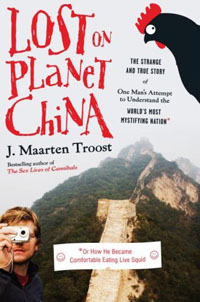Lost on Planet China

Which superpower regularly exports inferior goods, infiltrates other economies, has a questionable human rights record, and preemptively wars against other sovereign nations? Strong evidence can be presented that the U.S.A. fits that bill, but let's go with the conventional view and name the People's Republic of China. Unfortunately, that array of indictments obscures the vast complexity and delights of this awakened giant. A few Westerners, including Peter Hessler and Jonathan Spence, have taken on the task of explicating the inscrutable and sometimes impenetrable Chinese to the outside world.
While not aspiring to the explication of China as a career, with Lost on Planet China: The Strange and True Story of One Man's Attempt to Understand the World's Most Mystifying Nation, or How He Became Comfortable Eating Live Squid, madcap travel writer J. Maarten Troost (The Sex Lives of Cannibals), who unabashedly mimics the style of Michael Palin, offers a less orthodox approach to constructing a Chinese travelogue. Troost covers significant territory, wandering through Beijing and Shanghai and traveling to the Gobi Desert and backwater Tibet. While there Troost engages in what his publisher describes as his "trademark gonzo adventures," treading where wiser men may, uh, demure.
